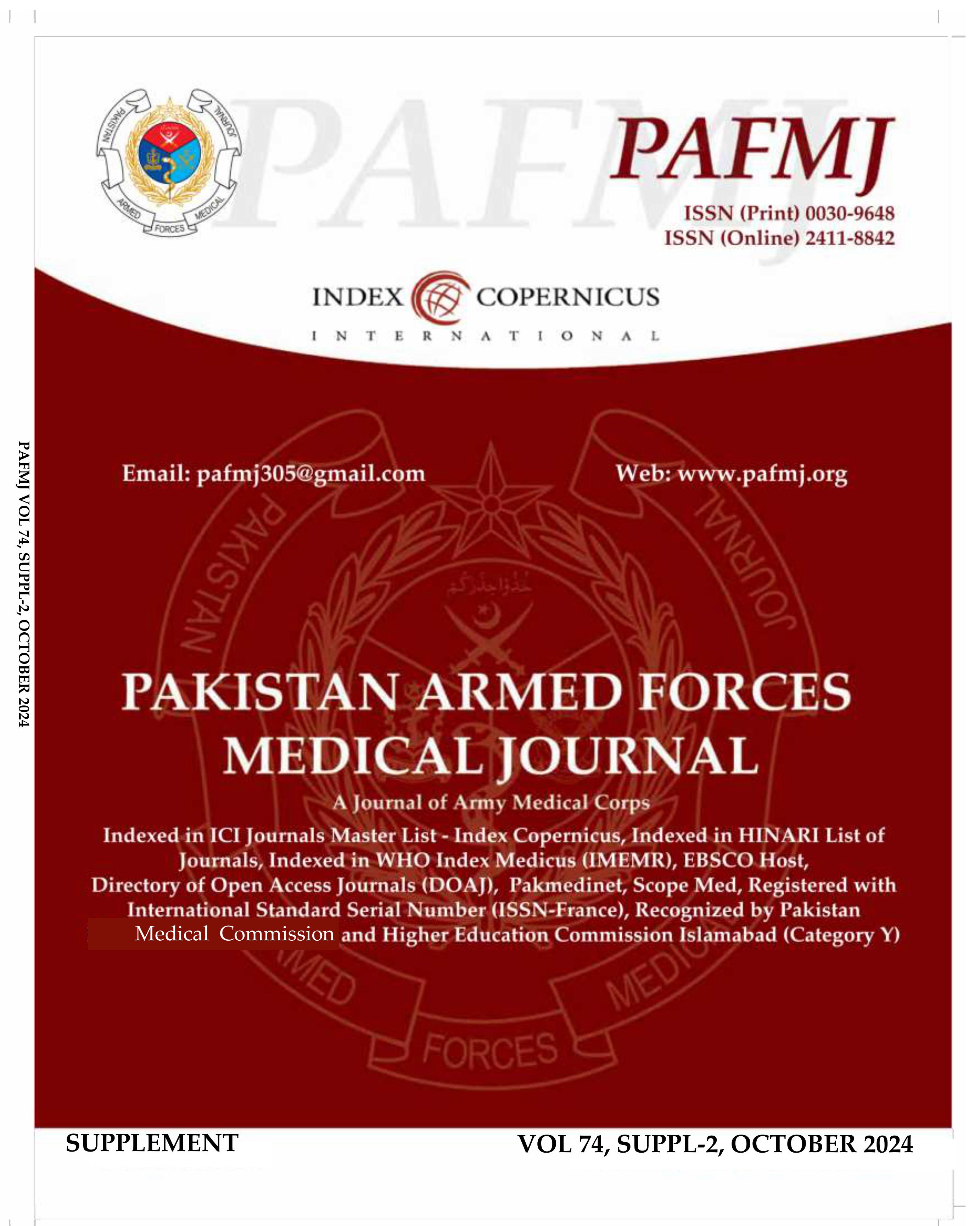Comparison of Efficacy of Cyclophosphamide Versus Tacrolimus in Children With Steroid Dependent and Frequent Relapsing Nephrotic Syndrome
DOI:
https://doi.org/10.51253/pafmj.v74iSUPPL-2.7255Keywords:
Cyclophosphamide, Nephrotic syndrome, Tacrolimus.Abstract
Objectives: To compare the efficacy of Cyclophosphamide and Tacrolimus in the management of steroid dependent and frequent relapsing nephrotic syndrome in children.
Study Design: Quasi Experimental Study.
Place and Duration of Study: Department of Pediatric Nephrology, The Children's Hospital & The Institute of Child Health, Multan, from July 2020 to Dec 2020.
Methodology: A total of 120 patients presenting with steroid dependent and frequent relapsing nephrotic syndrome that need 2nd line drug were divided in two groups. Group A included patients using Cyclophosphamide in a dose of 2.5mg/kg and group B used Tacrolimus in a dose of 0.1mg/kg. All patients were monitored and compliance of drugs were noted.Efficacy was calculated as proportions of patients achieving maintained remission of disease for six months duration.
Results: Our study included n=80(66.7%) boys versus n = 40(33.3%) were girls having mean age 5.93±2.10 years (range 1 – 12 years). Mean weight was noted to be 17.1±3.84 kilograms. Majority 46cases (76.6%) in Tacrolimus–group achieved complete remission compared to 22cases (36.6%) in Cyclophosphamide-group, that results in usually exceedingly noteworthy p<0.005. Partial remission and drug resistance were 12cases (20%) and 2cases (3.33%) of Tacrolimus–group compared to 20cases (33.3%) and 18cases (30%) in Cyclophosphamide-group respectively. Sustained remission at 6months follow-up was 40cases (66.7%) in Tacrolimus–group compared to 16cases (26.6%) in Cyclophosphamide-group.
Conclusion: Tacrolimus was more effective in inducing remission (76.6%) as compared to cyclophosphamide (36.6%) in steroid dependent and frequent relapsing Nephrotic syndrome.
Downloads
References
Sinha MD, MacLeod R, Rigby E, Clark AG. Treatment of severe steroid-dependent nephrotic syndrome (SDNS) in children with tacrolimus. Nephrol Dial Transplant. 2006 Jul; 21(7): 1848-1854.
Supavekin S, Surapaitoolkorn W, Kurupong T, Chaiyapak T, Piyaphanee N, Pattaragarn A, et al. Tacrolimus in steroid resistant and steroid dependent childhood nephrotic syndrome. J Med Assoc Thai. 2013 Jan; 96(1): 33-40.
Van Husen M, Kemper MJ. New therapies in steroid-sensitive and steroid-resistant idiopathic nephrotic syndrome. New therapies in steroid-sensitive and steroid-resistant idiopathic nephrotic syndrome. Pediatr Nephrol. 2011 Jun; 26(6): 881-892.
Couderc A, Bérard E, Guigonis V, Vrillon I, Hogan J, Audard V, et al. Treatments of steroid-dependent nephrotic syndrome in children. Arch Pediatr. 2017 Dec; 24(12): 1312-1320.
Golay M, Douillard A, Nagot N, Fila M, Ichay L, Dalla Vale F, et al. Childhood steroid-dependent idiopathic nephrotic syndrome: Predictive factors for the need of immunosuppressive treatment. Arch Pediatr. 2017 Nov; 24(11): 1096-1102.
Webb H, Jaureguiberry G, Dufek S, Tullus K, Bockenhauer D. Cyclophosphamide and rituximab in frequently relapsing/steroid-dependent nephrotic syndrome. Pediatr Nephrol. 2016 Apr; 31(4): 589-594.
Chen SY, Wu CY, Tsai IJ, Tsau YK. Treatment course of steroid-dependent nephrotic syndrome: emphasized on treatment effect. Nephrology(Carlton). 2010 Apr; 15(3): 336-339.
Oh J, Kemper MJ. Second-line options for refractory steroid-sensitive and -resistant nephrotic syndrome. Expert Rev Clin Pharmacol. 2010 Jul; 3(4): 527-537. doi: 10.1586/ecp.10.31.
Sijan Thapa1 and Hongzhu Lu1. Efficacy of Tacrolimus in Treating Nephrotic Syndrome Children. Br J Med Med Res. 2016; 12(6): 1-8.
Sinha A, Bagga A, Gulati A, Hari P. Short-term efficacy of rituximab versus tacrolimus in steroid-dependent nephrotic syndrome. Pediatr Nephrol. 2012 Feb; 27(2): 235-241. doi: 10.1007/s00467-011-1997-4. Epub 2011 Sep 16.
Basu B, Babu BG, Mahapatra TK. Long-term efficacy and safety of common steroid-sparing agents in idiopathic nephrotic children. Clin Exp Nephrol. 2017 Feb; 21(1): 143-151. doi: 10.1007/s10157-016-1266-8. Epub 2016 Apr 23.
N. Prasad, R. Manjunath, D. Rangaswamy, A. Jaiswal, V. Agarwal,1 D. Bhadauria, et al. Efficacy and Safety of Cyclosporine versus Tacrolimus in Steroid and Cyclophosphamide Resistant Nephrotic Syndrome: A Prospective Study. Indian J Nephrol. 2018 Jan-Feb; 28(1): 46–52.
Jahan I, Hanif M, Ali MA, Hoque MM. Prediction of Risk Factors of Frequent Relapse Idiopathic Nephrotic Syndrome. Mymensingh Med J. 2015 Oct; 24(4): 735-742.
Wenshan Lin, Hong-Yan Li, Shujun Lin, Tianbiao Zhou. Efficacy and safety of tacrolimus vs cyclophosphamide in the therapy of patients with idiopathic membranous nephropathy: a meta-analysis. Drug Des Devel Ther. 2019 Jul 11; 13: 2305-2330. doi: 10.2147/DDDT.S204974.
Honghong Zou, Fang Jiang, Gaosi Xu. Effectiveness and safety of cyclophosphamide or tacrolimus therapy for idiopathic membranous nephropathy. Ren Fail. 2019; 41(1): 673–681.
Oemar B, Brodehl J. Eight and 12 week courses of cyclophosphamide in nephrotic syndrome. Arch Dis Child. 1991 Jun; 66(6): 751. doi: 10.1136/adc.66.6.751
Thalgahagoda RS, Jayaweera AH, Karunadasa UI, Abeyagunawardena AS. Therapies for steroid‑sensitive nephrotic syndrome. Asian J Pediatr Nephrol 2018; 1: 56-61.
Paik KH, Lee BH, Cho HY, Kang HG, Ha IS, Cheong HI, Jin DK, Moon KC, Choi Y. Primary focal segmental glomerular sclerosis in children: clinical course and prognosis. Pediatr Nephrol. 2007 Mar; 22(3): 389-395. doi: 10.1007/s00467-006-0301-5.
Dongdong Wang, Jinmiao Lu, Qin Li, Zhiping Li. Population pharmacokinetics of tacrolimus in pediatric refractory nephrotic syndrome and a summary of other pediatric disease models. Exp Ther Med. 2019 May; 17(5): 4023–4031.
Xiao Chen, Dong-Dong Wang, Hong Xu, Zhi-Ping Li. Population pharmacokinetics model and initial dose optimization of tacrolimus in children and adolescents with lupus nephritis based on real-world data. Exp Ther Med. 2020 Aug; 20(2): 1423–1430.
Shasha Chen, Song Ren, Amanda Y. Wang, Hieu Tran, Zheng Li, Xiaoyun Cheng, et al.Comparison of the efficacy and safety of tacrolimus monotherapy and cyclophosphamide combined with glucocorticoid in the treatment of adult primary membranous nephropathy: protocol of a multicenter, randomized, controlled, open study. Trials. 2020; 21: 219. Published online 2020 Feb 24. doi: 10.1186/s13063-020-4144-3.
Khemani S, Moorani KN. Cyclosporine versus Cyclophosphamide in Childhood Nephrotic Syndrome. J Liaquat Uni Med Health Sci. 2016; 15(02): 57-62.
Malakasioti, G, Iancu, D. & Tullus, K. Calcineurin inhibitors in nephrotic syndrome secondary to podocyte gene mutations: a systematic review. Pediatr Nephrol. 2021; 36: 1353–1364.
Latta K, von Schnakenburg C, Ehrich J. A meta-analysis of cytotoxic treatment for frequently relapsing nephrotic syndrome in children. Pediatr Nephrol 2001; 16: 271-82.
Downloads
Published
Issue
Section
License
Copyright (c) 2024 Khuram Rashid, Muhammed Imran, Hashim Raza, Shahid Ishaq, Muhammad Amir Misbah ul Qamar, Tahira Sumreen

This work is licensed under a Creative Commons Attribution-NonCommercial 4.0 International License.















